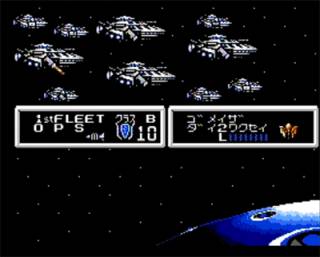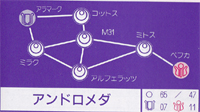Overview
 Commence planetary bombardment.
Commence planetary bombardment. The object of the game is to get the opponent to surrender their home world by crushing them utterly in combat. The two sides are the Gradians and the Bacterians; the Bacterians closely resemble their design from the MSX version of Salamander. Each side controls a home system; travel between the systems is achieved by warp points, which resemble worm holes. The player can choose to play against the computer, or can select a two-player mode for a match with a friend. The game has some amusing treats for the observant player; if the player completes the single-player mode, the brain golem of Salamander makes a cameo, apparently having been the computer player the whole time. In addition, many of the Bacterian commanders have names based off of sci-fi authors, such as "Hubbard" and "Bradbury".
Gameplay
 A sample system; in this case Andromeda.
A sample system; in this case Andromeda. Each match is divided in to both turns and phases. When one player completes all of his phases, the other player's turn begins. Combat initiates a special mode where combat continues until resolved; however, it still passes back and forth between players, it simply skips the other phases until one fleet or the other is defeated or until 3 sets of turns pass, whichever comes first. Both players start off with a set amount of resources; further income is generated each turn based on the number of worlds controlled. However, note that various other factors can influence this, including economic turmoil, which can make a player receive no income for a turn and consequently can put their war effort in disarray!
Each player begins in their home system; resources are generated here, ships are manufactured here, etc. A player can have up to 16 fleets active at any given time. in addition, each fleet can be composed of 16 (or less) units. Every fleet must be commanded by a flag ship. Each system also has a variety of "space terrain" ( these range from more conventional spacial bodies such asteroids, nebula clouds, etc. to Gradius staples like crystal fields or space cells) which can have positive or negative effects on ships fighting in or moving through them.
Phases
 The construction phase. The bacterians are constructing a diabolical fleet!
The construction phase. The bacterians are constructing a diabolical fleet!The following is the order in which the phases appear.
- Manufacturing Phase: The player gets to expend resources to manufacture ships for their fleets. Note that it takes one whole turn to complete manufacturing; ships are not available immediately.
- Commander Phase: The player gets to hire commanders for his or her fleets in this phase. The player gets to offer a certain amount of money (resources) and various captains will offer their services. Captains have different abilities which will affect the performance of their fleet in battle; I.E., some will make ships more resilient, more maneuverable, more accurate, etc. This phase requires the player's best judgement; once an offer is placed, the player cannot backtrack unless they choose to higher no captains at this time. Even if they offer a large amount of money, they may get unlucky and only worthless captains will offer their services. Likewise, they could offer a very small amount and an exception captain could appear!
- Formation Phase: In this phase, players get to build fleets for their captains to command. A captain must be assigned a fleet and placed in a flagship in order for a fleet to be composed. Each captain can have up to 16 ships total in their fleet, although beyond that the makeup is up to the player.
- Galactic Movement Phase: In this phase, the player can move his fleets via warp points to other systems as they see fit.
- Combat Phase: The players have the option to initiate combat in this phase if they feel so inclined. Obviously combat can only be initiated if opposing fleets are within range of each other. This causes both players to enter the aforementioned combat mode, with a total of six turns of combat before a temporary cessation. Players can also target claimed planets in this phase in an effort to wipe out the occupying forces and infrastructure and claim it as their own territory.
- Normal Movement Phase: The player can fine-tune the position of his ships in this phase, moving them about the star system they're currently in.
- Investment Phase: Players can improve the infrastructure of newly occupied planets in this phase, increasing their overall income. Once this phase is complete, the player's turn ends and the next player begins their turn.
Units
Both sides of the conflict have 16 different units at their disposal. Most of the units are nominally the same despite name variations and difference appearances to maintain balance between the two sides.
Gradians
 Buster-hou... UTEEEEEE!
Buster-hou... UTEEEEEE! - Flagship: A powerful Gradian flagship. These are required to lead a fleet. A captain must be placed in this for it to be deployed; he or she will add bonuses to the accompanying fleet. If it's destroyed the entire fleet is routed, so be careful!
- Battleship type A: A ship with very powerful offense and good range. However, it cannot target units that are adjacent, and cannot move and attack in the same turn. It is a staple of any fleet.
- Battleship type B: It is slightly cheaper to manufacture than the type A. However, it has exclusively long-range weapons; consequently, it can't target enemies that are near it (even more of an issue than with the regular battleship)
- Heavy cruiser: A solidly built ship which is capable of both long range and short range combat. Another fleet staple. They're a little expensive, but unfortunately less solidly built than a battleship.
- Light cruiser: A more maneuverable but less sturdy version of the heavy cruiser. It's a little bit cheaper.
- Destroyer type A: A smaller ship that is capable of short and long range combat. In addition, it can lay mines.
- Destroyer type B: A smaller, cheaper destroyer that is less mobile. It can lay mines as well.
- Missile ship: A flimsy ship with powerful missiles. Because of their high attack power and cheap manufacturing cost, these are a good throw-away ship. The player will lose a lot, but they'll take stuff down with them!
- Tender: For those not in the know, a tender is a ship designed to service other ships at sea. In any case, this ship can resupply other ships in the fleet with weapons as needed. It is virtually incapable of offense otherwise.
- D-Submarine: Submarines in space? Anyway, this ship is extremely heavily armored and is immune to the effects of terrain (i.e., meteors) but is is very slow moving and difficult to utilize.
- Scout Ship: A weak and largely useless scout vessel. However, it's the cheapest unit in the game.
- Space Carrier: What one would expect, a large ship designed to carry smaller ships in to combat. These are required to safely transport small fighters (such as Vic Vipers or the battle suits) through warp points; once fighters are in a system they can move about freely, but if they travel through a warp without a carrier, they are lost! Carriers are relatively sturdy, but weak on offense.
- Vic Viper: The classic Gradius ship. It's a cheap to build and fairly strong fighter, and is extremely maneuverable. Good for getting deep in the enemy fleet and taking out their battleships from close range!
- Battle Suits: Squads of mobile suits. While not quite as fast as the Viper, they are a bit sturdier and will last a long time.
- OPS: Simple ships which can be deployed as planetary defense. They are weak but cheap.
- Buster Cannon: The buster cannon can fire an extremely powerful beam which can totally annihilate large groups of enemy forces. However, it cannot move and fire and is totally defenseless and weak if enemies get in close. Use carefully!
Bacterians
 A bacterian cyber suit.
A bacterian cyber suit.- Bacterian: A powerful Bacterian flagship, unabashedly named after their own species. These are required to lead a fleet. A captain must be placed in this for it to be deployed; he or she will add bonuses to the accompanying fleet. If it's destroyed the entire fleet is routed, so be careful!
- Big Core: The seminal classic. It is similar to the Battleship Type A.
- Little Core: Much the same as the Battleship Type B, it has issues with enemy ships that are too close to it.
- Heavy Cruiser: Identical to the Gradian heavy cruiser, albeit with a creepy design.
- Light cruiser: A more maneuverable but less sturdy version of the heavy cruiser. It's a little bit cheaper.
- Destroyer type A: A smaller ship that is capable of short and long range combat. In addition, it can lay mines.
- Destroyer type B: A smaller, cheaper destroyer that is less mobile. It can lay mines as well.
- Missile ship: Identical to the Gradian missile ship, but of course with a different design.
- Tender: Identical to the Gradian tender in all but design.
- D-Submarine: Unsurprisingly the same as the Gradian version; it has the same issues in terms of usefulness, but with a different design.
- Cyber Eye: Much the same as the Gradian scout ship, it's once again largely worthless in combat, but cheap.
- Zellos: The Zellos ship serves as the carrier for the Bacterian navy.
- Vic Cyber: A cheap Bacterian counterfeit of the Viper, it performs much the same function.
- Cyber Suits: Identical to the Gradian Battle Suits, but with an organic twist.
- APS: The Bacterian equivalent of the OPS.
- Cyber Gun: The Bacterian equivalent of the Buster Cannon, it is functionally the same.
 Run for it!
Run for it!
Log in to comment